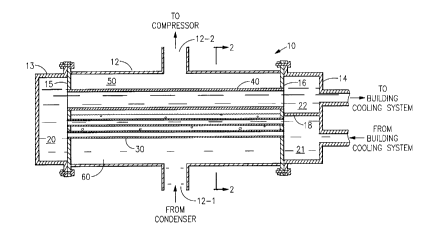Some of the information on this Web page has been provided by external sources. The Government of Canada is not responsible for the accuracy, reliability or currency of the information supplied by external sources. Users wishing to rely upon this information should consult directly with the source of the information. Content provided by external sources is not subject to official languages, privacy and accessibility requirements.
Any discrepancies in the text and image of the Claims and Abstract are due to differing posting times. Text of the Claims and Abstract are posted:
| (12) Patent: | (11) CA 2219699 |
|---|---|
| (54) English Title: | LOW PRESSURE DROP HEAT EXCHANGER |
| (54) French Title: | ECHANGEUR DE CHALEUR A FAIBLE CHUTE DE PRESSION |
| Status: | Deemed expired |
| (51) International Patent Classification (IPC): |
|
|---|---|
| (72) Inventors : |
|
| (73) Owners : |
|
| (71) Applicants : |
|
| (74) Agent: | NORTON ROSE FULBRIGHT CANADA LLP/S.E.N.C.R.L., S.R.L. |
| (74) Associate agent: | |
| (45) Issued: | 2002-08-13 |
| (22) Filed Date: | 1997-10-30 |
| (41) Open to Public Inspection: | 1998-05-21 |
| Examination requested: | 1997-10-30 |
| Availability of licence: | N/A |
| (25) Language of filing: | English |
| Patent Cooperation Treaty (PCT): | No |
|---|
| (30) Application Priority Data: | ||||||
|---|---|---|---|---|---|---|
|
A two pass heat exchanger is provided. The first pass includes a plurality of tubes
located in liquid refrigerant, when employed as an evaporator, whereby the liquid
refrigerant draws heat from the water flowing through the tubes causing the water to
be cooled and the liquid refrigerant to evaporate. The second pass is a single pipe
which need not be located in the liquid refrigerant. The two pass heat exchanger can
also be used as a condenser.
Cette invention concerne un échangeur de chaleur à deux parcours. Le premier parcours, en mode évaporateur, se fait dans une série de tubes immergés dans un frigorigène liquide. Ce liquide extrait la chaleur de l'eau qui circule dans lesdits tubes et se vaporise durant le processus. Le deuxième parcours se fait dans un tube unique qui n'a pas besoin d'être immergé dans le frigorigène liquide. L'objet de l'invention peut aussi servir de condenseur.
Note: Claims are shown in the official language in which they were submitted.
Note: Descriptions are shown in the official language in which they were submitted.

For a clearer understanding of the status of the application/patent presented on this page, the site Disclaimer , as well as the definitions for Patent , Administrative Status , Maintenance Fee and Payment History should be consulted.
| Title | Date |
|---|---|
| Forecasted Issue Date | 2002-08-13 |
| (22) Filed | 1997-10-30 |
| Examination Requested | 1997-10-30 |
| (41) Open to Public Inspection | 1998-05-21 |
| (45) Issued | 2002-08-13 |
| Deemed Expired | 2009-10-30 |
There is no abandonment history.
| Fee Type | Anniversary Year | Due Date | Amount Paid | Paid Date |
|---|---|---|---|---|
| Request for Examination | $400.00 | 1997-10-30 | ||
| Registration of a document - section 124 | $100.00 | 1997-10-30 | ||
| Application Fee | $300.00 | 1997-10-30 | ||
| Maintenance Fee - Application - New Act | 2 | 1999-11-01 | $100.00 | 1999-09-15 |
| Maintenance Fee - Application - New Act | 3 | 2000-10-30 | $100.00 | 2000-09-20 |
| Maintenance Fee - Application - New Act | 4 | 2001-10-30 | $100.00 | 2001-10-02 |
| Final Fee | $300.00 | 2002-05-28 | ||
| Maintenance Fee - Patent - New Act | 5 | 2002-10-30 | $400.00 | 2003-08-22 |
| Maintenance Fee - Patent - New Act | 6 | 2003-10-30 | $350.00 | 2004-05-13 |
| Maintenance Fee - Patent - New Act | 7 | 2004-11-01 | $200.00 | 2004-09-24 |
| Maintenance Fee - Patent - New Act | 8 | 2005-10-31 | $400.00 | 2005-12-14 |
| Maintenance Fee - Patent - New Act | 9 | 2006-10-30 | $200.00 | 2006-09-20 |
| Maintenance Fee - Patent - New Act | 10 | 2007-10-30 | $250.00 | 2007-09-21 |
Note: Records showing the ownership history in alphabetical order.
| Current Owners on Record |
|---|
| CARRIER CORPORATION |
| Past Owners on Record |
|---|
| HUENNIGER, EDWARD A. |